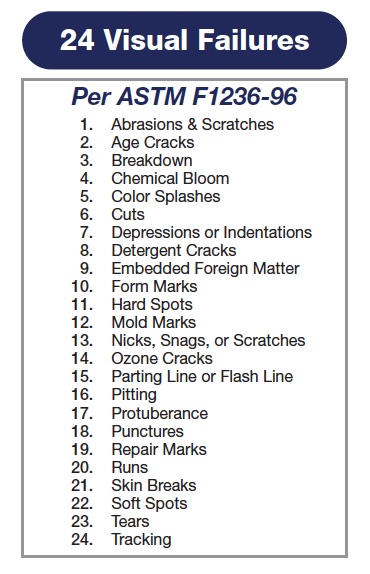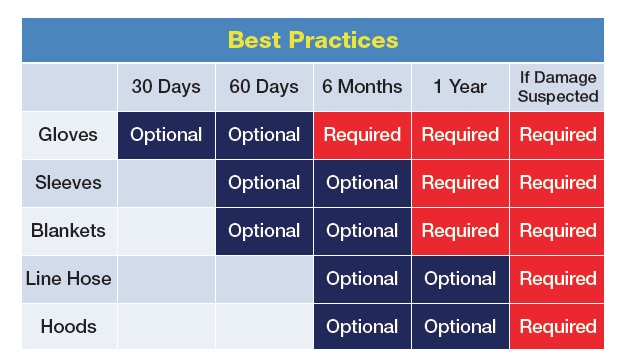Rubber Goods: All Eyes on Safety with Daily Visual Inspections
"Being safe is not a matter of good luck. It is deliberate attention to what we do and how we do it which includes the highest integrity of our rubber goods, the testing services and individual ownership of their visual inspection of their rubber products." ~Eliza Wilcox, Leader of People, HR and Safety for Green Mountain Power (GMP), an electric utility company with a strong commitment to safety education.
Every day, electrical workers rely heavily on Personal Protective Equipment (PPE) to ensure they arrive home safe at the end of the their work shifts. Not only is wearing the required certified PPE the safest choice, it's also an ASTM requirement, enforced by OSHA.
Considered the first line of defense in the event of an electrical incident, dielectric rubber goods (gloves, sleeves, blankets, line hoses, hoods, boots, and related products) are one of the most widely used forms of PPE. Since they play such a pivotal role, the ASTM F18 Committee has issued stringent requirements for required daily inspections and regular testing intervals on new and in-service goods. Because OSHA enforces ASTM guidelines, lack of compliance can mean significant fines. Ensuring that these goods are safe requires deliberate attention to one of the finer details over which we have control.
Protect what's protecting you: Rubber is very insulating, but it's also easily susceptible to breakdown from the elements, as well as damage throughout the course of regular use. Aside from everyday nicks, cuts, and scratches, other factors can impact integrity; these include improper storage, age, climate, and exposure to petroleum-based products. Based on its class, rubber is designed to withstand electrical conditions up to a maximum amount of voltage. The higher the class, the thicker the product, and the higher maximum electrical current it is able to withstand. For this reason, a simple weak point, nick, or cut can provide an easy gateway for potential electrical current to access the user. This can result in injury or death.
But, what if my goods are new? Surprisingly, new goods are not exempt from damage! The process of manufacturing rubber goods is laden with ways where goods can be compromised. Even new goods can have air bubbles, color splatter, folds, scratches, etc. Some of this can be missed at the quality control step before the goods leave the plant, or during the shipping process.
Per ASTM D-120, OSHA 1910.137 standards, rubber goods must be acceptance tested (also known as proof-tested) before their first use. Therefore, a rubber goods testing lab that performs a full visual inspection in addition to an electrical test, as a part of the initial acceptance process, will rule out initial quality issues with new goods, while also certifying them for use with a fresh date stamp. Shockingly, an average of 12-15% of new goods fail the initial out-of-the-box testing standards; imported rubber goods are often 3-4 times higher. Luckily, if inspection is completed at purchasing, the distributor/testing lab will typically handle the return behind the scenes and immediately sub in a replacement. The costly alternative tends to be when goods are not proof-tested at all, despite safety requirements and the threat of OSHA fines. These failures come to light at the retesting stages six months later or longer -too late for any warranty reimbursement from the manufacturer. Quite understandably, this leads to increased failure replacement costs.
Daily Visual Inspections for Safety: ASTM requires daily rubber visual inspections before every use (ASTM F496-08, F479-06, F478-06) to rule out many of these potentially damaged goods. A complete visual inspection process includes inspecting the inside and outside of the product. Gloves should also be air tested (inflated using a rolling technique or with a field inflator), as the stretching of the rubber can reveal less obvious damage.
What to check for:
- Imperfections and damage: ASTM F1236-96 outlines 24 types of visual failures that should prompt the user to remove the goods from service. Be on the lookout for even the smallest pinhole or scuff. (see list below)

- A current test date: a complete date stamp includes the name of the testing facility, tested voltage, max use voltage, and either the date of the most recent test or expiration date of the goods. If the date of test is used, please see the chart on Rubber Goods Best Practices, to determine if the amount of time between ASTM mandated tests has lapsed.
- If damage is suspected: Should there be any visual damage - even the smallest pinhole, scratch, age cracking or otherwise - remove the goods from service immediately and send them to a certified rubber goods inspection lab that will provide a complete visual and electrical test to ASTM / OSHA standards. A lab that is additionally accredited by NAIL for PET (North American Independent Laboratories for Protective Equipment Testing) is recommended.

Inspection continues as a part of the rest of your day. "If you suspect at any time you have damaged your rubber goods while in the work zone... come off of the project, out of the work zone, and inspect them," says John Voyer, Substation Operations Manager of GMP, "If you nick your protectors, even if you don't think it went through, come down from your work zone and inspect the rubber. After you come back from lunch you inspect them again. It's important you do this with all safety equipment."
Reducing damage through proper storage: Protecting your personal protective equipment will support your safety initiative, while also prolonging the life of the goods. When not in service, rubber-insulating goods should be stored (clean) in a location as cool, dark, and dry as possible. Climate is very important, and can be one of the most challenging variables to control, because temperatures that are too cold, too hot, too humid or too dry can all effect rubber. Many times, goods are kept in work vehicles, storage crates, dusty warehouses, and the like. Unfortunately, even though it's not in use, the rubber goes through a breakdown or spoilage, which results in cracking or hard spots. This makes the goods inadequate for proper protection and puts the user at risk. Additionally, any storage location should be free from ozone and other chemicals that could harm the rubber. Even the plastic bags that new or newly tested goods are sent in do not protect the rubber from climate or ozone related breakdown.
Canvas bags are an excellent way to store rubber products. Make sure to remove leather protectors from gloves prior to storing, as the tanning chemicals can leech onto the gloves when wet and cause them to turn white. Store gloves with fingers up, sleeves flat, and blankets loosely rolled. Goods should never be folded or creased, as weak spots will form where the rubber is compressed.
Final field check - avoid complacency: You'll think an incident isn't going to happen... until it does. Avoid distractions. Remember that the time you take for safety is worth far more than the alternative. Always ensure you're following the ASTM, OSHA, and company best practices for safety. "The thing that is kind of unique about safety is you never know if you have gotten it right - it's hard to quantify that. It's so hard to say how many accidents have been avoided. We don't see this at GMP, however that mentality could potentially drive a lot of complacency." ~John Voyer, Substation Operations Manager, GMP
While it's easy to be swept up in the current project, a time crunch, or a feeling of invincibility or complacency... it's critical to make a daily and deliberate commitment to your safety initiatives. Daily visual inspections, regular testing cycles, proper storage, avoiding field complacency and following company best practices are a few of the ways that you can control your own safety and reap the bigger reward - going home safely at the end of the day.
K.D. Aiardo serves as the marketing manager of Hi-Line Utility Supply, a division of WESCO and a leader in tools, equipment, safety supplies and services for the electrical industry. K.D. has over five years in the industry and is committed to creating a quality customer experience based on education, the importance of standard compliance, and safety.
Hi-Line Utility Supply | www.hilineco.com
Joseph Cardona is an applications engineer with the HPS Safety Products Business Unit. His product lines include Gloves, Cover Up, Meters & Instruments, and Grounding. Joseph graduated from the University of Missouri-Columbia with a Bachelors and Masters of Science in Mechanical Engineering. He has been with HPS for six and a half years - three years with customer service and three and a half in the Safety Products Business Unit.
Hubbell Power Systems | www.hubbellpowersystems.com
Eliza Wilcox, Leader of HR & Safety at Green Mountain Power (GMP), has strong knowledge and passion for recruitment, employee relations, leadership, employee development, training and injury prevention. Eliza has experience in a variety of corners of the business which has allowed her to proactively build and sustain strong relationships across the organization to positively impact business performance, foster creative solutions, grow our fast, fun, safe and effective culture, empower leaders, transform the traditional utility model all while our goal is set at zero injuries. As a team, we continue to foster a safety culture transformation from reactive to proactive by effectively influencing all levels and areas of the organization.
John Voyer, Manager of Substation Operations for Green Mountain Power (GMP), is responsible for the safe, reliable operation and maintenance of Green Mountain Power's Substation facilities throughout the State of Vermont. John has experience in a variety positions within the electrical power industry. He is a Vermont Licensed Master Electrician, Journeyman Lineworker, and a rated Relay Technician along with experience in his previous role as Manager of Power Production at GMP.
Green Mountain Power | www.greenmountainpower.com
Volume: 2017 March/April












.jpg?r=2245)